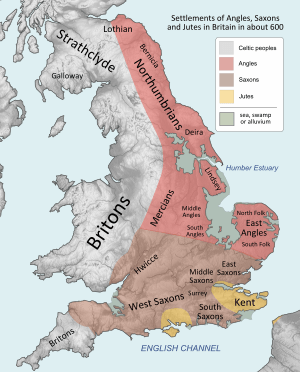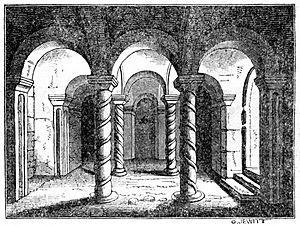Medeshamstede facts for kids
Medeshamstede was the original name for Peterborough during the Anglo-Saxon times. It was home to an important monastery (a community for monks) that started in the mid-600s. This monastery was a big deal in the kingdom of Mercia right from the start. We don't know much about its founder, Sexwulf, but he was an important person who later became a bishop in Mercia. Medeshamstede quickly grew, gaining many smaller churches connected to it. It also became a center for a special Anglo-Saxon style of sculpture.
We don't know much about Medeshamstede's history after the late 800s. The Anglo-Saxon Chronicle says that in 864, Vikings destroyed the monastery and killed the Abbot and monks. It wasn't until the late 900s that it was rebuilt. Bishop Æthelwold of Winchester restored it as a Benedictine abbey (a type of monastery) during a time when many monasteries in England were being reformed. Because of this restoration, Medeshamstede soon became known as "Peterborough Abbey".
Contents
What Does "Medeshamstede" Mean?

Experts believe the name "Medeshamstede" means "homestead belonging to Mede." A homestead is a place where a family lives, often with a farm.
The Anglo-Saxon Chronicle (specifically the Peterborough version, written in the 1100s) says the name came from a spring called "Medeswæl," meaning "Medes-well." However, many people think "Medeshamstede" simply means "homestead in the meadows" or something similar, because "Medes-" sounds like "meadows."
The earliest reliable mention of the name is in Bede's Ecclesiastical History from the 670s. It was called "Medeshamstedi" in Latin. But people lived in this area long before that. For example, there was a Bronze Age settlement at Flag Fen and a Roman town called Durobrivae nearby. So, "Medeshamstede" might have been the name of an older settlement that existed before the monastery.
Over time, the name changed slightly. Later, it became "Burh," meaning "fortified place." To tell it apart from other places called "Burh," people added "Peter" after Saint Peter, the monastery's main saint. This is how it got its modern name, "Peterborough."
A Key Monastery in Mercia
A Royal Beginning

Medeshamstede was located in Mercia, close to the border with East Anglia. Historian Sir Frank Stenton called it "one of the greatest monasteries of the Mercian kingdom." Hugh Candidus, a monk from Peterborough in the 1100s, wrote a history of the abbey. He described its location as a "fair spot" with rich fenland (marshy areas), good water, and plenty of farmland, woods, and pastures.
Hugh Candidus also said Medeshamstede was founded in the land of the "Gyrwas." These were a group of people mentioned in an old document called the Tribal Hidage. The Gyrwas were divided into North and South Gyrwas, and Medeshamstede was in the North Gyrwas' territory. Hugh Candidus explained that "Gyrwas" meant people "who dwell in the fen," because a deep bog was called Gyr in the Saxon language. This shows that people in the area were still known as "Gyrwas" in his time.
According to Bede, a man named Seaxwulf founded Medeshamstede and was its first abbot (the head of a monastery). Hugh Candidus described Seaxwulf as a "man of great power" who was very religious and skilled in both worldly and Church matters. Historians believe Seaxwulf might have been educated in East Anglia. He later became Bishop of Mercia.
A charter (an official document) from 664 AD mentions that King Wulfhere of Mercia added more land to the monastery. His deceased brother, King Peada, and King Oswiu of Northumbria had already started the monastery's funding. This charter was actually made later, but it shows the traditions of Peterborough Abbey. It also correctly places Medeshamstede's founding between about 653 and 656 AD.
Many local saints are connected to Medeshamstede, and many of them were related to the Mercian royal family. These include:
- Guthlac: A former monk from Repton, who is seen as the founder of Crowland Abbey, near Medeshamstede.
- Pega: Her name lives on in "Peakirk" (meaning "church of Pega"), near Medeshamstede. She was Guthlac's sister.
- Cyneburh and Cyneswith: Sisters of King Peada. Cyneburh started a nunnery (a community for nuns) at Castor, near Medeshamstede. Cyneswith took over as abbess (head nun) after her.
- Tibba: Believed to be a relative of King Peada, who lived as a recluse (someone who lives alone for religious reasons) at Ryhall.
- Tancred, Torhtred, and Tova: These three siblings are thought to have lived at Thorney, near Medeshamstede. They are said to have been killed during the Viking invasions in the late 800s.
- Tondberht: A "prince of the Gyrwas" and husband of St Æthelthryth of Ely. He is named as an English martyr.
- Tatwine: A monk from Breedon who became Archbishop of Canterbury. He was probably Guthlac's teacher.
Most of the churches linked to these saints were likely supported by Medeshamstede. The stories of Seaxwulf and these saints show that Medeshamstede was a very important religious center in Mercia, with strong ties to the royal family.
Spreading Christianity

King Wulfhere's charter and Bede's writings show that Medeshamstede was founded when Christianity was spreading in Mercia. Documents from Peterborough Abbey suggest that Medeshamstede played a key role in spreading Christianity in Mercia and other areas. It did this by creating many "daughter churches" (smaller churches connected to the main monastery).
These daughter churches included places like Breedon and Bermondsey. Medeshamstede is also thought to be the "mother church" of Repton, which was a royal burial place in Mercia in the 700s. Another document from Peterborough, written at Repton in 848 AD, shows that this network of monasteries continued for a long time. However, this is the last record of Medeshamstede's connection to its daughter churches. These connections likely ended in the late 800s due to Viking invasions.
The importance of these daughter churches, and Medeshamstede itself, is clear. Repton was a royal site, and Tatwine, a monk from Breedon, became the Archbishop of Canterbury. Also, St Guthlac was a monk from Repton.
Later Anglo-Saxon Times
Viking Attack
It is traditionally believed that Vikings destroyed Medeshamstede in 870 AD. This story comes from the Peterborough version of the Anglo-Saxon Chronicle and Hugh Candidus, both written in the 1100s. Many historical writings after the Norman Conquest often mentioned Vikings destroying churches. It was a common belief that Danish Vikings caused a long period of religious decline in England.
However, some historians think Medeshamstede might not have been completely destroyed. Some of its old documents from before the Viking attacks survived. This suggests there might have been some connection between the monastery before the Vikings and its rebuilding around 970 AD. The story of total destruction might have been a convenient way to explain why the monastery needed to be reformed.
Rebuilding in the 900s
Medeshamstede was rebuilt around 970 AD by Bishop Æthelwold of Winchester. He was helped by Ealdwulf, who became the new monastery's first abbot. Ealdwulf later became a bishop and an archbishop.
The monastery was soon surrounded by a huge stone wall and given a new name: "Burh," which means "fortified place." To tell it apart from other places with similar names, like the abbey at Bury St Edmunds, the name "Peter" was added. This was in honor of Saint Peter, the monastery's main saint. This is how the modern name "Peterborough" came to be.
What Remains Today?
The most famous Anglo-Saxon sculpture from Medeshamstede is the Hedda Stone. Experts believe it was made in the late 700s or early 800s. You can see it on display at Peterborough Cathedral today.
Archaeologists have also found parts of Anglo-Saxon buildings under the Cathedral, including foundations under the crossing and south transept. It's not clear if these are from the very first church.
The early buildings at Medeshamstede used materials, or "spolia" (reused stones), from nearby Roman sites. These included the old town of Durobrivae or a large Roman villa at Castor. Hugh Candidus wrote that when the church was being built, Sexwulf used "great stones, so mighty that eight yoke of oxen could scarcely draw any of them." He claimed Sexwulf wanted to build "a second Rome, or a daughter of Rome in England."
See also
 In Spanish: Medeshamstede para niños
In Spanish: Medeshamstede para niños


